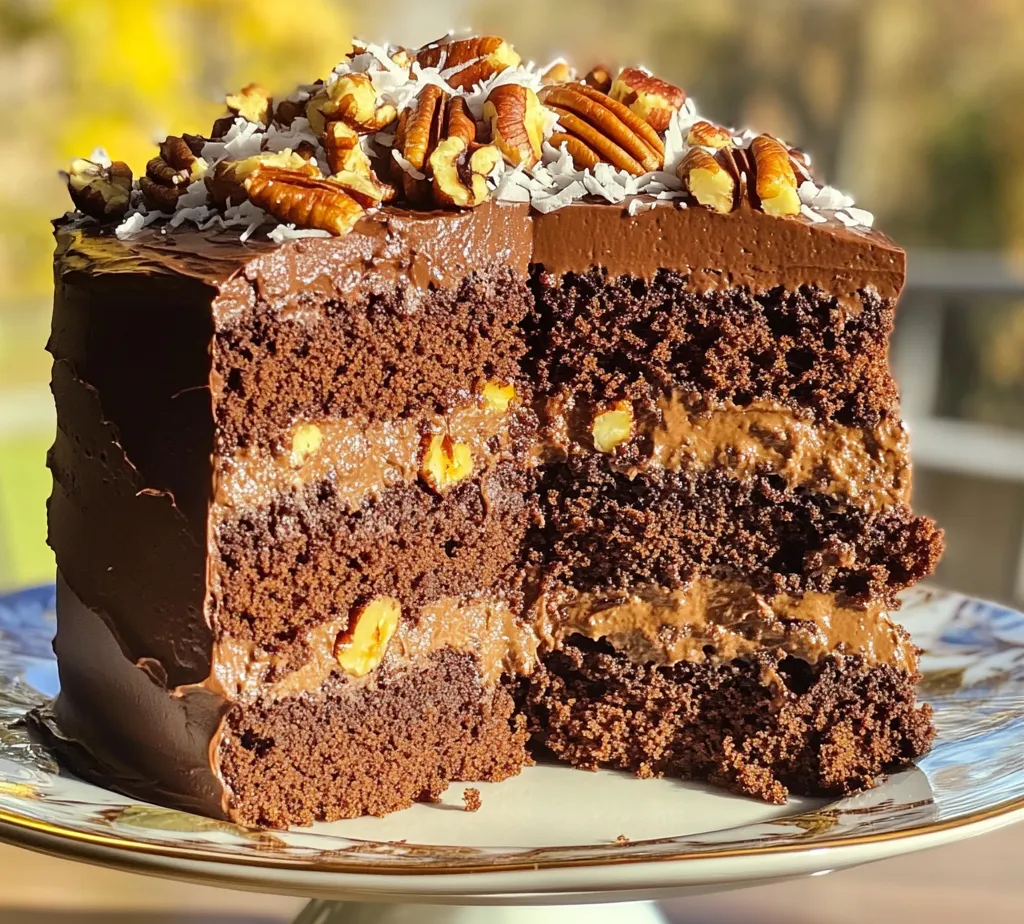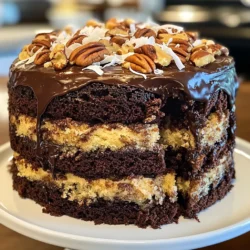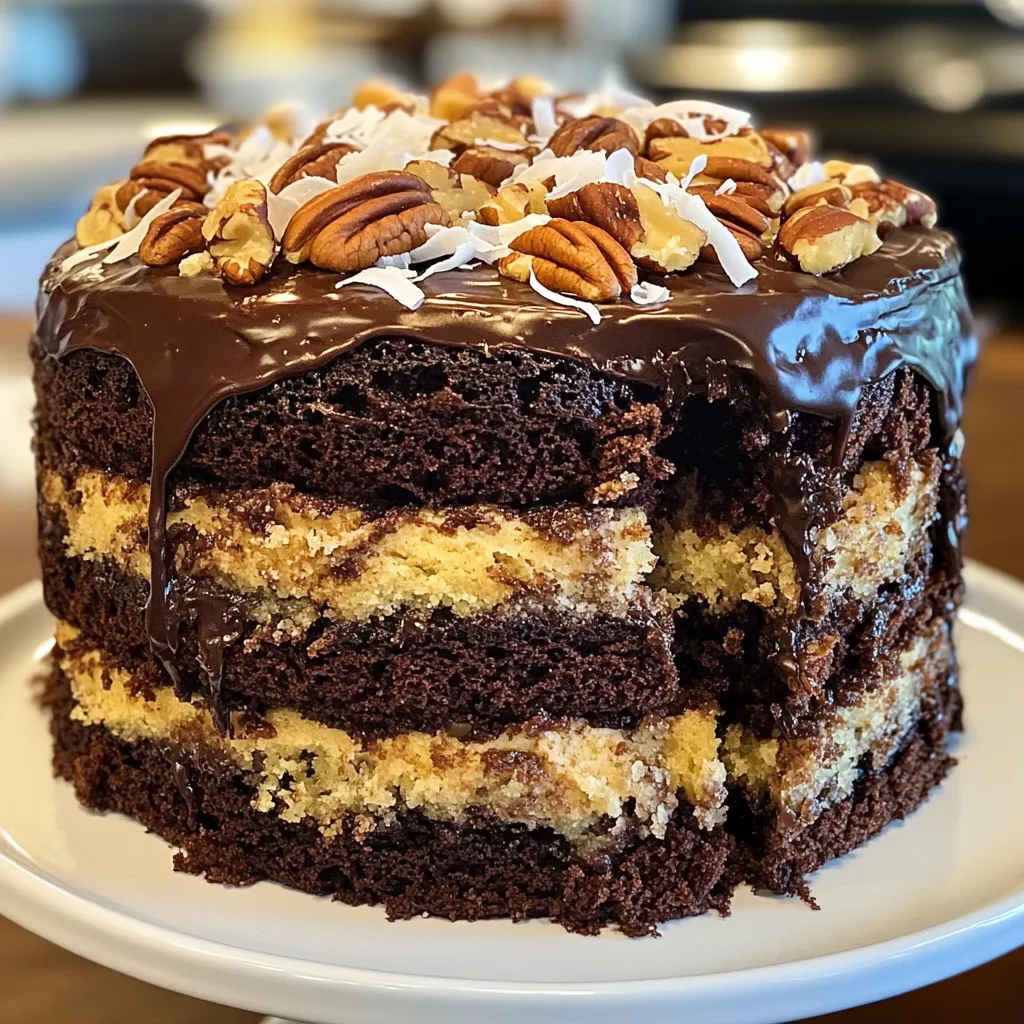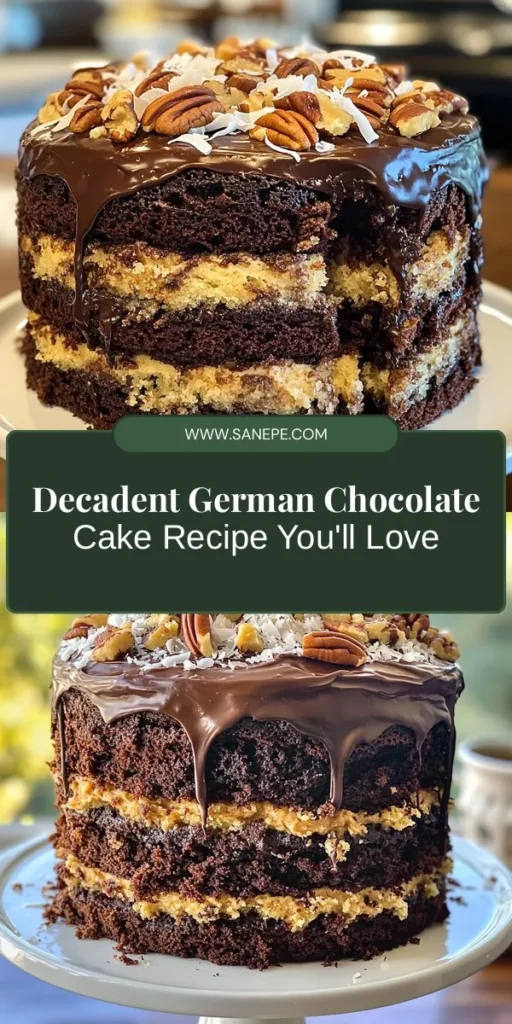Introduction
If you’re a dessert lover, the name “German Chocolate Cake” probably evokes delightful images of rich chocolate layered between creamy frosting, topped with a decadent coconut and pecan mixture. This classic cake is not only a feast for the taste buds but also a historical gem within the realm of baking. Contrary to what its name might suggest, German Chocolate Cake does not originate from Germany; rather, it is named after an American named Samuel German, who created a dark-baking chocolate for the Baker’s Chocolate Company in 1852. This chocolate became a key ingredient in the cake’s development, which has since captured the hearts and palates of many.
The indulgent nature of German Chocolate Cake lies in its multi-layered structure and the unique combination of flavors that come together to create a truly unforgettable dessert. The cake features a moist chocolate base, complemented by a rich coconut-pecan frosting that gives it its signature taste and texture. This cake is perfect for celebrations, gatherings, or simply satisfying a sweet tooth. In this article, we will take you through a detailed guide to creating this indulgent dessert from scratch, ensuring that you can replicate its magic in your own kitchen.
Understanding German Chocolate Cake
What sets German Chocolate Cake apart from other chocolate cakes is not just its name but also its distinct flavor profile and texture. Unlike standard chocolate cakes that may rely solely on cocoa powder or melted chocolate, German Chocolate Cake uses a unique combination of ingredients that contributes to its rich and complex flavor. The cake is characterized by its moist chocolate layers, which are typically made with a generous amount of cocoa powder, flour, and sugar.
One of the most notable features of this cake is its frosting. The traditional frosting is made from a mixture of sweetened shredded coconut and chopped pecans, combined with a creamy base made from evaporated milk and egg yolks. This frosting is not only rich and sweet but also provides a delightful contrast in texture to the soft chocolate cake. The combination of chocolate, coconut, and pecans creates an indulgent treat that is hard to resist.
As we dive deeper into the cake’s history, it’s essential to understand how a simple chocolate creation evolved into the beloved dessert we cherish today. The cake gained popularity in the United States in the mid-20th century when a Texas homemaker published a recipe for “German’s Chocolate Cake” in a local newspaper. This recipe utilized Samuel German’s chocolate, and the cake quickly became a favorite across the nation, solidifying its place in American baking.
Ingredients Breakdown
To create an indulgent German Chocolate Cake, it’s crucial to understand the role of each ingredient, both in the cake and the accompanying frostings. Here’s a detailed breakdown of what you’ll need:
Cake Ingredients
1. All-Purpose Flour: The backbone of your cake, flour provides the necessary structure. It absorbs moisture and gives the cake its body.
2. Unsweetened Cocoa Powder: This is the star ingredient that imparts the rich chocolate flavor. It adds depth and complexity to the cake, making it truly decadent.
3. Granulated Sugar: Sugar sweetens the cake and helps to create a moist texture. It plays a crucial role in the cake’s overall flavor profile.
4. Baking Powder and Baking Soda: These leavening agents are essential for creating a light and fluffy texture. They help the cake rise during baking.
5. Salt: A key player in enhancing flavors, salt balances the sweetness of the sugar and highlights the chocolate.
6. Buttermilk: This ingredient adds moisture to the cake and contributes to its tender crumb. The acidity in buttermilk also interacts with the baking soda, helping the cake rise.
7. Vegetable Oil: Oil keeps the cake moist and adds richness. It’s a great alternative to butter in cake recipes, as it helps create a softer texture.
8. Eggs: Eggs provide structure and stability to the cake. They also add moisture and richness, contributing to the overall flavor.
9. Boiling Water: This may seem unusual, but adding boiling water to the batter helps to dissolve the cocoa powder, ensuring an even distribution of chocolate flavor throughout the cake.
Coconut-Pecan Frosting Ingredients
1. Evaporated Milk: This ingredient is essential for achieving the creamy texture in the frosting. It adds richness and helps bind the other ingredients together.
2. Egg Yolks: Egg yolks contribute to the frosting’s richness and help it thicken as it cooks. They also provide a smooth, velvety texture.
3. Granulated Sugar: Just like in the cake, sugar is crucial for sweetness in the frosting. It helps create a thick, gooey texture that adheres well to the cake layers.
4. Butter: Butter adds flavor and richness, enhancing the overall taste of the frosting.
5. Sweetened Shredded Coconut: This ingredient gives the frosting its signature texture and flavor, adding a tropical twist to the cake.
6. Chopped Pecans: Pecans provide a crunchy contrast to the creamy frosting, adding depth and a nutty richness.
Chocolate Frosting Ingredients
1. Unsweetened Cocoa Powder: Just like in the cake, cocoa powder is essential for creating a rich chocolate flavor in the frosting.
2. Butter: A critical ingredient for a smooth and creamy frosting, butter adds richness and helps achieve the right consistency.
3. Powdered Sugar: This ingredient sweetens the frosting and provides a fine texture. Powdered sugar dissolves easily, making it ideal for frosting.
4. Milk: Milk adjusts the consistency of the frosting, ensuring it’s spreadable and not too thick or too runny.
5. Vanilla Extract: A splash of vanilla enhances the overall flavor of the frosting, rounding out the sweetness and adding a hint of warmth.
Step-by-Step Guide to Preparing Indulgent German Chocolate Cake
Now that we have an understanding of the ingredients and their significance, let’s dive into the process of preparing this indulgent German Chocolate Cake. Follow these steps carefully to create a cake that is both visually appealing and delicious.
Preparing the Cake Batter
1. Preheat the Oven: The first step is to preheat your oven to 350°F (175°C). Preheating is crucial as it ensures that your cake bakes evenly and rises properly.
2. Prepare the Cake Pans: Grease and flour two 9-inch round cake pans. Alternatively, you can line the bottoms with parchment paper for easier removal once the cakes are baked. Proper preparation of the pans prevents sticking and ensures a smooth release.
3. Mixing the Dry Ingredients: In a medium bowl, sift together the all-purpose flour, unsweetened cocoa powder, baking powder, baking soda, and salt. Sifting helps to aerate the dry ingredients and prevent lumps, resulting in a lighter cake.
4. Creaming the Butter and Sugar: In a large mixing bowl, combine the granulated sugar and vegetable oil. Using an electric mixer, beat the mixture on medium speed until it’s light and fluffy. This step is essential for incorporating air into the batter, which contributes to the cake’s texture.
5. Add the Eggs: One at a time, add the eggs to the creamed butter and sugar mixture, mixing well after each addition. This allows the eggs to blend thoroughly, ensuring a uniform batter.
6. Incorporate the Buttermilk: Gradually add the buttermilk to the mixture while continuing to mix on low speed. The buttermilk not only adds moisture but also helps to activate the baking soda, resulting in a well-risen cake.
7. Combine Dry Ingredients and Boiling Water: Alternately add the dry mixture and boiling water to the batter, starting and ending with the dry ingredients. Mix on low speed until just combined. The boiling water enhances the flavor of the cocoa and creates a smooth batter.
8. Baking the Cakes: Divide the batter evenly between the prepared cake pans. Bake in the preheated oven for 30-35 minutes or until a toothpick inserted into the center of the cakes comes out clean. Be careful not to overbake, as this can result in a dry cake.
9. Cooling the Cakes: Once baked, remove the cakes from the oven and allow them to cool in the pans for about 10 minutes. Then, carefully turn them out onto a wire rack to cool completely before frosting.
This detailed process will ensure that your German Chocolate Cake is moist, flavorful, and ready to be transformed into the indulgent dessert it is meant to be. In the next part of this article, we will delve into creating the delicious coconut-pecan frosting and the chocolate frosting that completes this decadent treat. Stay tuned for the continuation of this sweet journey!

Best Practices for Checking Doneness
When baking an Indulgent German Chocolate Cake, ensuring that it is properly baked is crucial for achieving a moist and fluffy texture. One of the simplest yet most effective methods to check for doneness is the toothpick test. Insert a toothpick into the center of the cake; if it comes out clean or with a few moist crumbs clinging to it, the cake is ready. If the toothpick comes out with wet batter, it needs more time in the oven. Additionally, you can gently press the top of the cake with your finger—if it springs back, it’s a sign that the cake is done. Monitoring the cake closely during the last few minutes of baking can help avoid overbaking, which can lead to a dry cake.
Cooling Techniques: How to Properly Cool Cakes to Prevent Sogginess
Proper cooling of your German Chocolate Cake is just as important as the baking process itself. Once your cake layers are out of the oven, allow them to cool in their pans for about 10-15 minutes. This resting time helps the cake firm up slightly and makes it easier to remove from the pans without breaking. After this initial cooling, gently run a knife around the edges of the pans to loosen the cake. Invert the cake onto a wire rack to cool completely.
Cooling on a wire rack is essential because it allows air to circulate around the cake, preventing it from becoming soggy. Avoid covering the cake while it is still warm, as this will trap steam and moisture, resulting in a less-than-ideal texture. Let the layers cool completely before frosting, ensuring that the frosting does not melt or slide off.
Making the Coconut-Pecan Frosting
The star of the German Chocolate Cake is undoubtedly the rich Coconut-Pecan Frosting. This frosting combines the flavors of toasted coconut and crunchy pecans, creating a delightful contrast to the soft chocolate layers.
Cooking Process: How to Achieve the Right Consistency and Flavor Depth
To make this frosting, start by combining granulated sugar, evaporated milk, unsalted butter, and egg yolks in a saucepan over medium heat. Stir constantly until the mixture thickens and turns a golden color, which typically takes about 10-12 minutes. This process not only thickens the frosting but also enhances the flavors.
Once thickened, remove the pan from the heat and stir in vanilla extract, shredded coconut, and chopped pecans. Allow the frosting to cool completely before spreading it on the cake. Cooling is crucial, as it allows the frosting to set to a spreadable consistency. If you find your frosting too thick after cooling, you can add a splash of milk to achieve the desired texture.
Tips for Incorporating Coconut and Pecans Effectively
Toasting your coconut and pecans before adding them to the frosting enhances their flavors significantly. Simply spread the coconut and pecans on a baking sheet and bake at 350°F (175°C) for about 5-7 minutes, stirring occasionally until they are golden brown. Toasting adds depth and complexity to the frosting, making it even more indulgent.
Preparing the Chocolate Frosting
While the Coconut-Pecan Frosting cools, you can prepare the Chocolate Frosting. This layer adds a rich chocolate flavor that complements the sweetness of the coconut and pecan topping.
Achieving the Perfect Spreadable Texture: Balancing Butter, Sugar, and Milk
In a large mixing bowl, beat softened unsalted butter until creamy. Gradually add powdered sugar, alternating with cocoa powder and a splash of milk, until you achieve a smooth and spreadable consistency.
To ensure your Chocolate Frosting is not too thick, adjust the milk quantity as needed. If the frosting is too thin, simply add a bit more powdered sugar. The cocoa powder will impart a deep chocolate flavor, so use a high-quality cocoa for the best results.
Flavor Nuances: How Cocoa Powder Impacts the Overall Taste
The choice of cocoa powder can significantly affect your frosting’s flavor. Dutch-processed cocoa has a smoother, more mellow flavor, while natural cocoa powder is more acidic and has a more robust chocolate taste. Experimenting with different types can enhance your frosting’s flavor profile and align it with your personal preference.
Assembling the Cake
Once your cake layers are completely cool and your frostings are ready, it’s time to assemble the cake.
Layering Techniques: How to Evenly Distribute Frosting Between Layers
Start by placing one layer of chocolate cake on a serving plate or cake stand. Spread a generous layer of Coconut-Pecan Frosting on top, ensuring it reaches the edges. Gently place the second layer on top and repeat the frosting process.
For the final layer, cover the top and sides of the cake with Chocolate Frosting, smoothing it out with a spatula. To create a textured finish, you can use the back of a spoon or a cake comb to create swirls or patterns.
Decorative Tips: Suggestions for Presenting the Cake Beautifully
To elevate the cake’s appearance, consider garnishing it with extra toasted coconut and pecans on top. You can also add chocolate shavings or curls for an elegant touch. If you wish to add a personal flair, use piping bags to pipe decorative borders or rosettes along the edges.
Serving Suggestions
Indulgent German Chocolate Cake is perfect for various occasions, from birthdays to holidays and celebrations. Its rich flavors and beautiful presentation make it a showstopper dessert that guests will love.
Ideal Occasions for Serving German Chocolate Cake
This cake is particularly popular for birthday parties, anniversaries, and family gatherings. Its unique flavor profile sets it apart from more common cakes, making it a special treat. Additionally, it’s a great dessert to serve at potlucks, as it can be made a day in advance and still tastes delicious.
Pairing Ideas: Beverages that Complement the Rich Flavors of the Cake
For beverages that pair well with German Chocolate Cake, consider serving it with a glass of cold milk or a rich coffee. The bitterness of the coffee balances the sweetness of the cake, making for a delightful combination. For a more festive touch, you might also serve it with a dessert wine or a light sparkling wine, which can cleanse the palate between bites.
Storage and Shelf Life
If you happen to have leftovers (which can be rare given its deliciousness), proper storage will keep your Indulgent German Chocolate Cake fresh for days.
Best Practices for Storing Leftover Cake
Store your cake in an airtight container at room temperature for up to three days. If your kitchen is particularly warm or humid, consider refrigerating it to ensure the frostings maintain their texture and flavor.
Tips on Keeping the Cake Moist and Fresh for Days
To keep the cake moist, avoid cutting into it until you’re ready to serve. If you have slices left, wrap them individually in plastic wrap to prevent them from drying out. You can also place a slice of bread in the container with the cake; the bread will absorb excess moisture, helping to keep the cake fresh.
Conclusion
Baking an Indulgent German Chocolate Cake is not just about following a recipe; it’s a delightful experience that brings joy in the process of creating something delicious. From the rich layers of chocolate to the sweet Coconut-Pecan Frosting, each element works together to create a dessert that is both indulgent and memorable.
As you embark on your baking journey, don’t hesitate to experiment and make this recipe your own. Share your results with friends and family, and revel in the joy of bringing a slice of happiness to any occasion. Embrace the process, enjoy the flavors, and let the decadent nature of this classic dessert inspire your culinary adventures.


